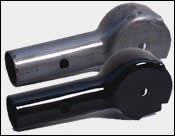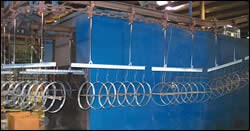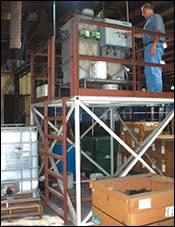Pretreatment Switch Nets Six-Figure Annual Savings
One-step cleaner/phosphate system pays off at Microfinish
For more than 45 years, Micro finish Co. Inc., with three plants in St. Louis and Warrenton, MO, has handled contract metal finishing jobs for producers of auto parts, vending machines, electrical controls and lawn equipment. Originally involved in tumbling and plating, the company now operates a fully automated zinc electroplating facility, a vibratory finishing plant, and two powder coating lines.
The company’s Warrenton plant operates two powder lines: a large line with an environmental room surrounding an automated eight-gun spray booth, and a smaller batch line that is semi-automated and can handle parts to 24 ft long. The primary line has a cycle time of 1 hr, 15 min, and runs at speeds of 8-12 fpm depending on the parts being processed.
The plant processes a wide variety of parts—steel stampings, die-cast aluminum components, wire products, and other part types. “They’re all sizes, and they come to us in all kind of condition as far as cleanliness, so we have to have a system that can handle a wide range of parts,” explains plant manager David Piant.
In the fall and winter of 2004-2005, the rising cost of natural gas was taking a toll on profits in Microfinish’s powder coating operation. Each 2-million-btu burner in the company’s conventional cleaner/phosphate system was using 930 million btu per month. Managers set out to investigate ways to save on gas costs.
The company was already familiar with microbial cleaning, having used BioPrep 20/100 self-regenerating cleaner, manufactured by BioClean, USA (Bridgeport, CT), in its zinc plating facility facility for many years. Microfinish managers remained skeptical about the use of a one-step cleaner/phosphate spray wash system in its powder coating operation, but the potential energy savings prompted the company to initiate an experimental switch.
Pretreatment Changeover
Microfinish had been using a traditional five-stage cleaner/phosphate system consisting of cleaner, rinse, iron phosphate, rinse and rinse stages, according to Piant.
“The stage 2 rinse ran at 140°F, and the phosphate ran at 135°F,” he explains. “We had tried an ambient-temperature phosphate, but you really need a stainless tank for that. Our tanks are carbon steel.
“On the old system, we had to drain the alkaline cleaner tank every two months to remove the sludge and recharge it,” he continues. “We adjusted the pH so we could go to drain with the old cleaner, and sludge was hauled to our St. Louis plant for disposal.”
Piant says Warrenton plant personnel drained and recharged the conventional phosphate tank every four months, and did the same with the rinse tanks at least once a week. “That was water that was lost down the drain,” he recalls. “We went through 250 gal of cleaner concentrate a month, and 250 gal of phosphate every two months.”
Operating Improvements
Microfinish made the switch to the one-step cleaner/phosphate system early in 2005. Combining cleaner and phosphate into a single stage allowed managers to turn off one burner. The company instantly realized energy savings of 25-30%. “We only heat stage 1 now,” Piant explains. “There’s enough residual heat in stage 2 to have some extra cleaning and phosphating without additional energy costs, and stages 3 and 4 are just rinses now.”
An added bonus was water and chemical savings enabled by the closed-loop system. Instead of using nine gallons of water per minute, the new system required only three gallons per minute. “We counterflow the rinses and use that water to make up stage 2 and 1,” says Piant. “We have a little bit of overflow here, that’s why we still use three gallons per minute. Our water bill dropped from $1300 to $400 per month.” Chemical usage for the pretreatment system dropped 60%, he adds.
Nozzle and other equipment maintenance decreased from seven man-hours per week to less than one hour, translating into a labor savings of $1575 each month.
| Cost Savings: Conventional versus One-Step Pretreatment | |||
| Item |
Conventional Cost | One-Step Cost | Monthly Savings |
| Natural gas | $10,400 | $7000 | $3400 |
| Water/sewer | $1300 | $300 | $1000 |
| Chemicals | $3700 | $720 | $2980 |
| Labor | 7 man-hrs/week | <1 man-hour/week | $2060 |
| TOTAL SAVINGS | $9440 | ||
Dumping and waste disposal is no longer required.
“We’re still adjusting to the new maintenance schedule,” Piant says. “On the rinses we dump and recharge every two months, and on the wash itself it’s every six months.
“What we’re going to do is put the cleaner in a holding tank, get the sludge out, and then recharge the tank with the same fluid. We don’t have to dispose of it because all the oils are eaten up by the enzymes in the solution.”
Environmentally, the system has practically eliminated discharges to drain. “Occasionally, the local sewage people used to come in if they were having a foaming problem,” Piant recalls. “They’d take readings and records, and it was never our plant. But we haven’t seen them since we switched to this—there’s hardly any water discharged from it.”
Quality Improvements
According to Piant, the company is seeing improved part quality in addition to the operating benefits from the combined cleaner/pretreatment system. Parts have improved corrosion resistance both in-process and after powder coating.
“Once parts are through the pretreatment process and dried off, we don’t have to worry about them rusting,” he says. “We used to have more problems with that.” Coated parts have exhibited improved salt spray testing resistance, probably due to better powder adhesion, he adds.
How It Works
BioPrep CP cleaner/iron phosphate is a low-temperature, self-regenerating solution that simultaneously cleans and prepares metals for painting and powder coating. The patented product uses naturally occurring bacteria to consume oils and greases removed from parts during cleaning, eliminating contaminant buildup and extending the life of the solution.
A control module supplied by Bioclean automatically monitors and replenishes the pretreatment solution to maintain proper operating conditions. The bath normally runs at concentration of 3-5% by volume at a temperature of 105-135°F and pH of 5-5.5. Process time in a spray application is 1-2 minutes. Stainless tanks are recommended, but the product can also run in mild steel tanks.
“You don’t have to worry about oils, because the bacteria eat them and constantly reproduce themselves,” Piant explains. “The system is controlled by the clarifier, which constantly recirculates water, adjusts the pH, and adds chemicals as needed.”
According to Piant, workers check pH twice per shift and send samples to Bioclean monthly for analysis. “The bacteria count is controlled mainly by pH,” he explains. “Too high, and they go dormant. Too low, they reproduce really fast and they can actually eat up all the food and then die off.” The population of bacteria in the solution is huge—107 to 108 microbes per cubic centimeter.
System pH is maintained in the 4.5-5.5 range. “The pH goes up as the bugs reproduce, so if it’s off it usually goes high,” Piant says. “Then we add phosphoric acid to bring it back down.” Running aluminum parts also tends to drive up the solution pH, he adds.
Samples sent to BioClean, USA are analyzed for cleaner concentration, subcomponents like molybdenum and phosphorus, pH, bacteria count, and other parameters. “We don’t need a chemist here to constantly adjust things,” Piant says. “We send samples of the solution off to Bioclean, and they let us know what, if anything, we need to do. But as long as enough cleaner is still there, we’re usually OK.”
One of the main system maintenance tasks is removal of dead bacteria, which would cause an unpleasant odor if left in the system. The system uses a lamellar plate clarifier to remove dead bugs, which settle to the bottom of the clarifier tank and are drawn off. “We bleed off a gallon or so a week of dead microbes and other sludge that accumulates in the clarifier,” Piant says.
One key feature of the system is a pump—essentially, an oversize model of the type used in fish tanks—that constantly aerates the solution even if the line is down for extended periods. The aerobic bacteria in the system require air to keep reproducing and consuming oils and greases, so they work especially well in spray systems such as that operated by Microfinish.
The one-step cleaner/phosphate is available in several variations optimized to handle different types of oils and greases. For example, one formulation is aimed at cleaning of wire goods, which tend to be coated with stearate-based drawing compounds that can be difficult to remove. Another allows zero-hydrogen processing of sensitive aerospace components.
Related Content
Zinc Phosphate: Questions and Answers
Our experts share specific questions about zinc phosphate and pretreatment
Read MoreCuring Oven Basics
Simply heating up the substrate does not cure the coating. There are many variables to consider when choosing the best cure oven for your application...
Read MoreProducts Finishing Reveals 2024 Qualifying Top Shops
PF reveals the qualifying shops in its annual Top Shops Benchmarking Survey — a program designed to offer shops insights into their overall performance in the industry.
Read MoreHenry Ford Is Still Right When It Comes to Color
Who would have imagined that more than 100 years after his famous statement about any color as long as it’s black would still have relevance of a sort?
Read MoreRead Next
Delivering Increased Benefits to Greenhouse Films
Baystar's Borstar technology is helping customers deliver better, more reliable production methods to greenhouse agriculture.
Read MoreEducation Bringing Cleaning to Machining
Debuting new speakers and cleaning technology content during this half-day workshop co-located with IMTS 2024.
Read MoreEpisode 45: An Interview with Chandler Mancuso, MacDermid Envio Solutions
Chandler Mancuso, technical director with MacDermid Envio discusses updating your wastewater treatment system and implementing materials recycling solutions to increase efficiencies, control costs and reduce environmental impact.
Read More

























